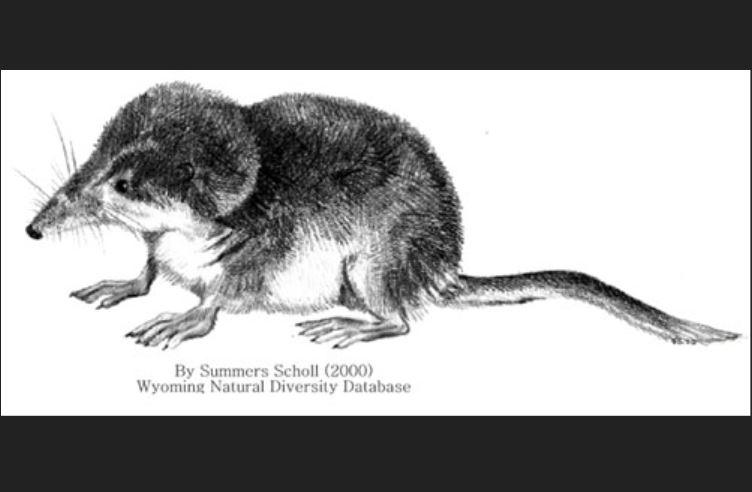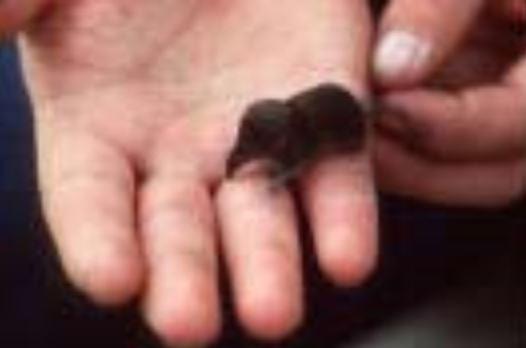Moderate
Preble’s shrew is a poorly known species that appears to be extremely rare in Washington; additional sampling is needed to understand distribution, habitat needs, and factors that affect populations.
Description and Range
Physical description
Oregon Department of Fish and Wildlife describes Preble’s shrew as follows: …{A]dults commonly weigh less than a dime. The pelage (fur) is medium dark-brown to very dark-gray on the dorsum (topside) and silvery gray on the ventral (underside). The tail is bicolored, medium dark-brown on the dorsal surface, which on the ventral surface and darkening toward the tip.
Ecology and life history
Preble’s shrews are most often associated with sagebrush and grasses but have been collected in a wide variety of habitats, including subalpine shrubland, whitebark pine, and wetlands. In Washington, Preble’s shrews have been captured in dense lodgepole pine, dense subalpine fir/lodgepole, and grand fir/Engelmann spruce forest at 5,000 to 6,000 feet in the Blue Mountains, which is rather atypical habitat for the species. It was also captured in a U.S. Department of Agriculture - Conservation Reserve Program grassland.
Preble’s shrew is an insectivore; mandible morphology suggests a diet of soft-bodied invertebrates, such as spiders and grubs.
Litter size is estimated to be three to six young.
Shrews are active throughout the year and forage under the snow in colder regions. Life expectancy is less than 1½ years.
Geographic range
As currently recognized, the range of Preble’s shrew includes southern British Columbia, south to northeastern California, northern Nevada and Utah and east to western Wyoming and Colorado, and south to New Mexico and north to include much of Montana. However, a future taxonomic revision may split the species, restricting the name Sorex preblei to populations in Washington, Oregon, British Columbia, California and Nevada.
In Washington, the only records of Preble’s shrew were from the Blue Mountains in 1956 to 1958, until 2004 when a single specimen was captured in Douglas County. There are no density estimates or data on population numbers in Washington or elsewhere. Preble’s shrews seem to be very rare, though this may partly be an artifact of inadequate sampling. Population trends can only be hypothesized from the reduction in steppe habitats; less than 50 percent of the historical shrubsteppe in Washington remains and much of the remainder is fragmented and degraded.
For a map of state/provincial conservation status and documented distribution of Preble’s shrew, check out NatureServe Explorer.
Climate vulnerability
Sensitivity to climate change
Moderate
Limited information is available regarding the biology and ecology of Preble's shrews and their potential response to climate change. This species is most often associated with shrubsteppe and grasslands, but also occupies a variety of other habitats such as forest, subalpine shrubland, and wetlands. In Washington, shrub-steppe and grasslands are expected to be stressed in the future by drier conditions, drought, and increased occurrence of wildfire, which may reduce habitat suitability and possibly prey availability (e.g., insects) for Preble's shrew. Further expansion of cheatgrass resulting from increased fires could also be detrimental to this species.
Exposure to climate change
Moderate
- Changes in precipitation
- Altered fire regimes
- Drought
- Increased invasive plants
Conservation
Conservation Threats and Actions Needed
- Resource information collection needs
- Threat: Lack of data on current distribution and population status.
- Action Needed: Determine distribution and population status.
- Threat: Lack of adequate information on threats.
- Action Needed: As better population distribution information is obtained, assess threats that may exist.
See the Climate vulnerability section for information about the threats posed by climate change to this species.
Resources
References
Carraway, L. N., and B. J. Verts. 1999. Records of reproduction in Sorex preblei. Northwestern Naturalist 80:115-116.
Cornely, J. E., L. N. Carraway, and B. J. Verts. 1992. Sorex preblei. Mammalian Species 416:1-3.
Gitzen, R. A., J. E. Bradley, M. R. Kroeger, and S. D. West. 2009. First record of Preble’s Shrew (Sorex preblei) in the northern Columbia Basin, Washington. Northwestern Naturalist 90: 41-43.
Hope, A. G., K. A. Speer, J. R. Demboski, S. L. Talbot, and J. A. Cook. 2012. A climate for speciation: rapid spatial diversification within the Sorex cinereus complex of shrews. Molecular Phylogenetics and Evolution 64: 671–684.
Johnson, R. E., and K. M. Cassidy. 1997. Mammals of Washington state: location data and modeled distributions. Washington State GAP Analysis, Volume 3. Washington Cooperative Fish and Wildlife Research Unit, Seattle, Washington.

